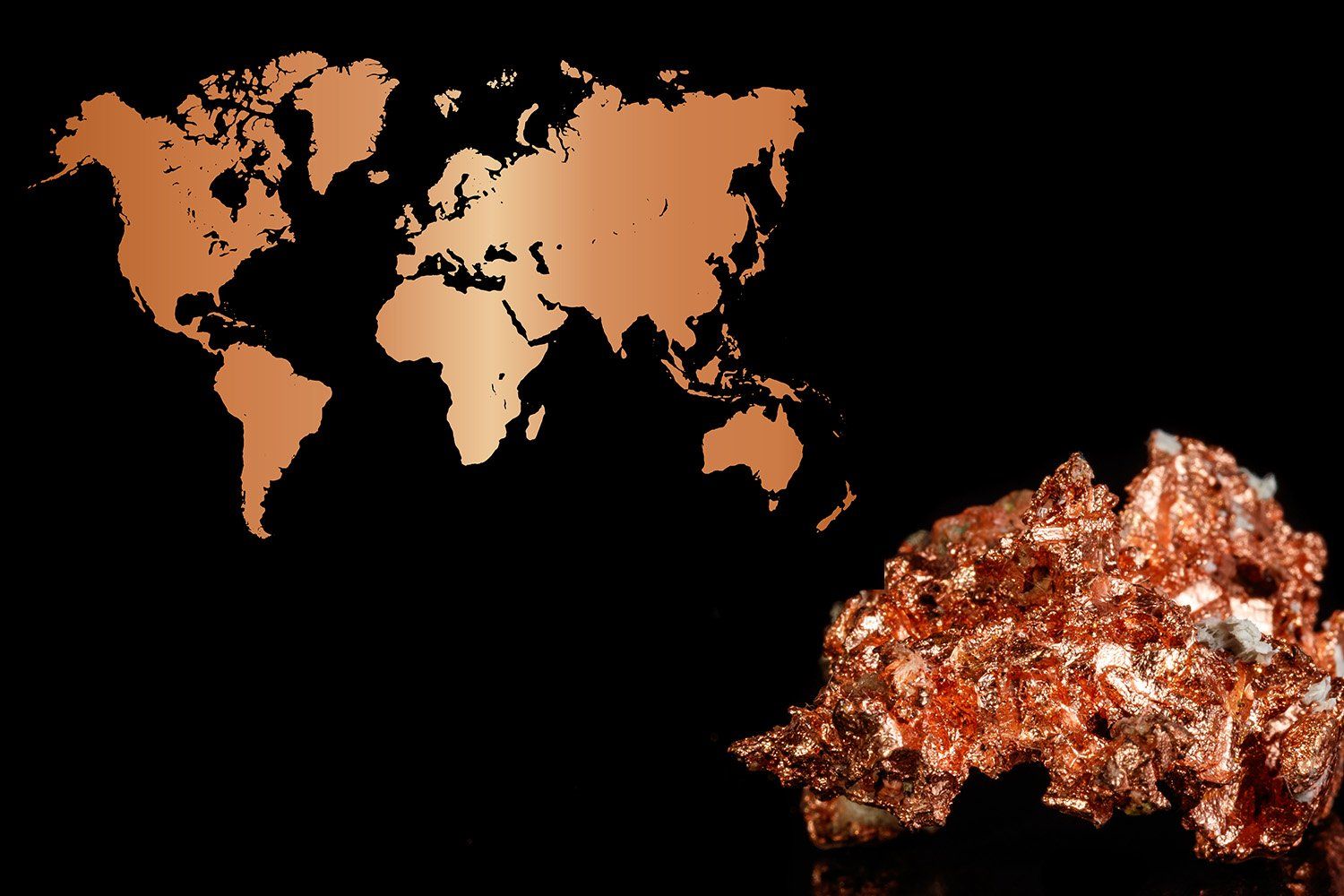
June 22, 2023
Aston Bay Holdings Ltd. (TSXV:BAY) (OTCQB:ATBHF) ("Aston Bay" or the "Company") reports significant new drill results from the spring reverse circulation (RC) drilling program at the Storm Copper Project ("Storm" or the "Project") on Somerset Island, Nunavut, Canada. The program was conducted this April and May by American West Metals Limited ("American West"), who are the project operator since entering an option agreement with Aston Bay in March 2021.
- Additional thick and high-grade near-surface copper intervals intersected at the 4100N Zone with numerous intervals over 5% Cu and a peak value of 8% Cu
- Drill hole SR23-13 has intersected:
- 29m @ 1.2% Cu from 62.5m, including,
- 3m @ 5% Cu from 86.9m, including,
- 1.5m @ 8.2% Cu from 86.9m
- 3m @ 5% Cu from 86.9m, including,
- Drill hole SR23-14 has intersected:
- 25.9m @ 1.3% Cu from 61m, including,
- 9.1m @ 2.1% Cu from 76.2m, including,
- 3m @ 3.7% Cu from 82.3m
- 9.1m @ 2.1% Cu from 76.2m, including,
- Drill hole SR23-07 has intersected:
- 10.7m @ 1.3% Cu from 76.2m, including,
- 4.6m @ 2.9% Cu from 76.2m, including,
- 1.5m @ 6.5% Cu from 76.2m
- 4.6m @ 2.9% Cu from 76.2m, including,
- Drill hole SR23-09 has intersected:
- 10.6m @ 1% Cu from 67.1m, including,
- 4.6m @ 2% Cu from 71.6m
- Copper mineralization remains open laterally in all directions
- These results continue to expand the volume of the near-surface mineralization and provide further support for the exploration potential of the large gravity anomaly located below the 4100N Zone
"We continue to receive impressive results from the RC program conducted at Storm by our partners America West Metals," stated Thomas Ullrich, CEO of Aston Bay. "The high grades, up to 8% copper in these results and higher elsewhere at Storm, speaks to the quality of the mineralized system, while its apparent continuity and consistency demonstrates a significant increase in the known near-surface high-grade mineralization.
"The 4100N Zone sits directly above the largest of several geophysical targets recently delineated at Storm, adjacent to faults that may have served as conduits for the mineralizing fluids. Our exploration model suggests that the 4100N Zone may be the uppermost of a series of stacked mineralized zones. This would be a game-changing discovery, and we eagerly look forward to testing this hypothesis in the upcoming summer drill program."
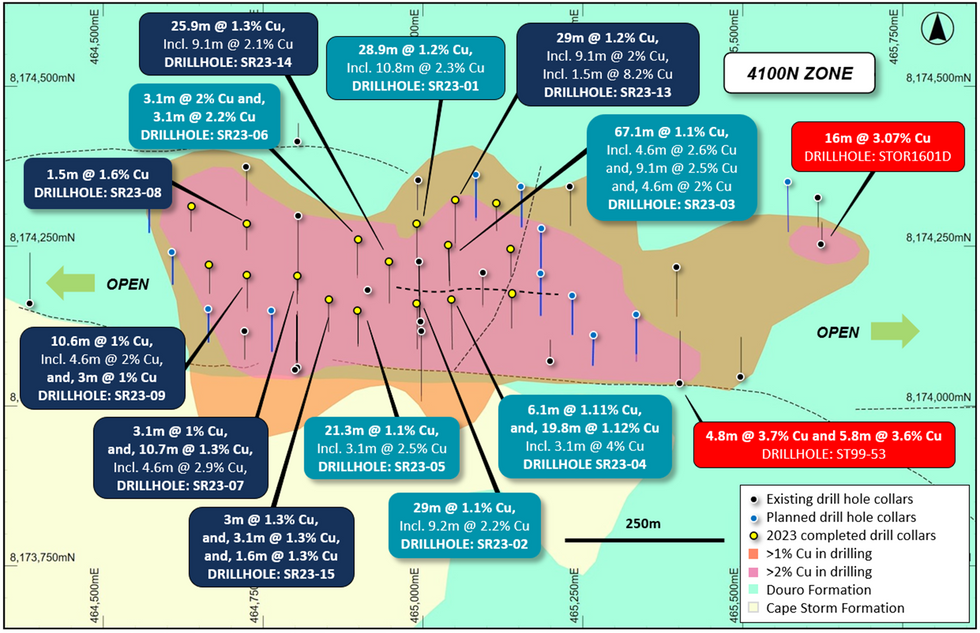
Figure 1: Plan view of the 4100N Zone showing interpreted copper mineralization footprint (defined by historical drilling and EM), historical and recent drilling details, overlaying regional geology. Stated drill hole intersections are all core length, and true width is expected to be 60% to 95% of stated length.
HIGH GRADES AND THICK INTERVALS CONTINUE
Assay results have been received and interpretation has been completed on drill holes SR23-07, SR23-08, SR23-09, SR23-13, SR23-14, and SR23-15. The drill holes are located within the central part of the 4100N Zone and have been prioritized to allow resource modeling on drill sections with complete data sets.
The drilling results continue to demonstrate consistent copper grades and excellent lateral continuity of the known copper mineralization. The mineralization is open along most sections and is defined by broad intervals of vein and fracture-style chalcocite, bornite and lesser chalcopyrite hosted within a distinct, horizontally extensive dolomite.
Multiple very high-grade lenses are located within the broader zones of mineralization, and these targets and further expansion of the mineralized footprint will be a focus for follow-up drilling in this zone.
Hole ID | Prospect | Easting | Northing | Depth (m) | Azimuth | Inclination | Copper Mineralized Interval (m) |
SR23-01 | 4100N | 464991 | 8174285 | 137.2 | 180 | -65 | 28.9 |
SR23-02 | 4100N | 464990 | 8174157 | 140.2 | 180 | -59 | 21 |
SR23-03 | 4100N | 465041 | 8174251 | 151 | 178 | -65 | 52.5 |
SR23-04 | 4100N | 465045 | 8174166 | 152.4 | 179 | -69 | 25.9 |
SR23-05 | 4100N | 464899 | 8174146 | 131.1 | 180 | -66 | 21.3 |
SR23-06 | 4100N | 464899 | 8174261 | 166.1 | 180 | -69 | 13.7 |
SR23-07 | 4100N | 464805 | 8174203 | 137.2 | 180 | -71 | 7.7 |
SR23-08 | 4100N | 464726 | 8174286 | 118.9 | 180 | -69 | 6.1 |
SR23-09 | 4100N | 464726 | 8174206 | 164.6 | 180 | -69 | 13.8 |
SR23-10 | 4100N | 464638 | 8174315 | 125 | 180 | -70 | 10.6 |
SR23-11 | 4100N | 464667 | 8174223 | 140.2 | 180 | -70 | 25.9 |
SR23-12 | 4100N | 465115 | 8174317 | 149.4 | 179 | -73 | 12.2 |
SR23-13 | 4100N | 465051 | 8174321 | 175.3 | 180 | -65 | 29 |
SR23-14 | 4100N | 464948 | 8174227 | 160 | 180 | -65 | 25.9 |
SR23-15 | 4100N | 464853 | 8174167 | 121.9 | 180 | -65 | 10.7 |
SR23-16 | 4100N | 465138 | 8174247 | 132.6 | 180 | -70 | 7.62 |
SR23-17 | 4100N | 465139 | 8174173 | 129.5 | 180 | -66 | 19.8 |
Table 1: 2023 program drill hole details and copper mineralization summary. The "Copper Mineralized Interval" data is based on laboratory assays (in bold) and visual estimates.
Visual estimates of mineral abundance should never be considered a proxy or substitute for laboratory analyses where concentrations or grades are the factor of principal economic interest. Laboratory assays are required to determine the presence and grade of any contained mineralization within the reported visual intersections of copper sulfides. Portable XRF is used as an aid in the determination of mineral type and abundance during the geological logging process.
DRILL HOLE SR23-07 DETAILS
SR23-07 was drilled to a downhole depth of 137.2m and is located on drill section 464,800E (Figure 2), the same section as historical drill holes ST97-14, ST99-56, and ST99-54.
SR23-07 intersected two horizontal zones of strong vein and fracture-style copper sulfide mineralization hosted within fractured dolomite. The grade and mineralogy are identical to that of the historical drill holes and confirm the excellent lateral continuity of the mineralization along this section.
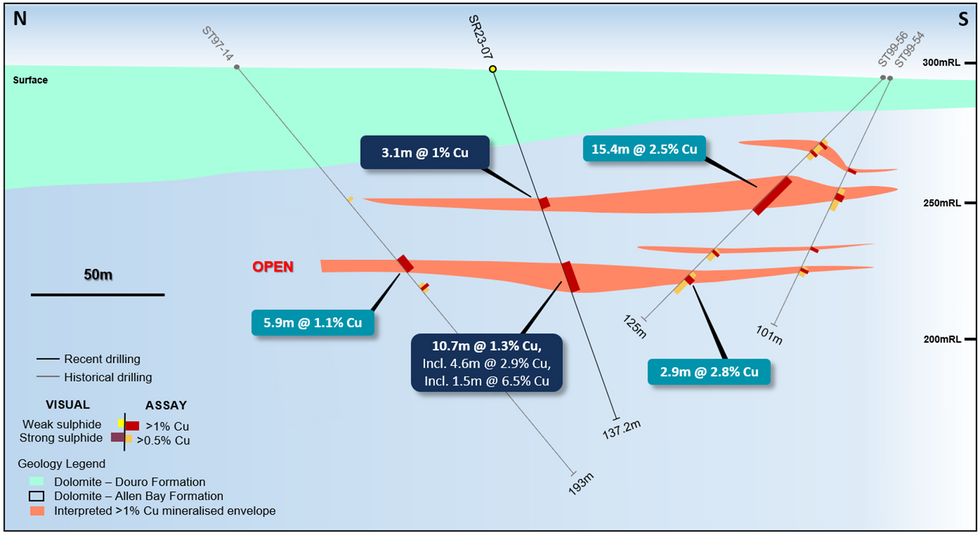
Figure 2: Geological section view at 464,800E showing the interpreted mineralization envelope (>>1% Cu) and recent drill hole assays and visual observations. Stated drill hole intersections are all core length, and true width is expected to be 60% to 95% of stated length.
Tables 2 - 7 below summarise the significant intersections in drilling. Intersections are expressed as downhole widths and are interpreted to be approximately 90-100% of true width. A cut-off grade of 0.5% copper is used to define a significant intersection and is based on mineralogy, mineralization habit and expected beneficiation performance.
Hole ID | From (m) | To (m) | Width | Cu % | Zn % | Ag g/t |
SR23-07 | 50.3 | 54.9 | 4.6 | 0.9 | - | 2 |
Including | 51.8 | 54.9 | 3.1 | 1 | - | 2.5 |
And | 76.2 | 86.9 | 10.7 | 1.3 | - | 2.9 |
Including | 76.2 | 80.8 | 4.6 | 2.9 | - | 5.7 |
Including | 76.2 | 77.7 | 1.5 | 6.5 | - | 13 |
Table 2: Summary of significant drilling intersections for drill hole SR23-07 (>0.5% Cu)
DRILL HOLE SR23-08 and SR23-09 DETAILS
SR23-08 and SR23-09 were drilled along section 464,725E (Figure 3). The drill holes were completed to a downhole depth of 118.9m and 164.6m respectively and were designed to test the continuity of the mineralization between the thick intervals of copper encountered within historical drill holes ST00-61 and ST00-62.
Both drill holes intersected wide zones of vein and fracture-style copper sulfide mineralization hosted within fractured dolomite. Higher-grade zones of mineralization (>2% Cu) are contained within the broader intervals of >1% copper sulfide mineralization.
The mineralization on drill section 464,725E remains open to the north.
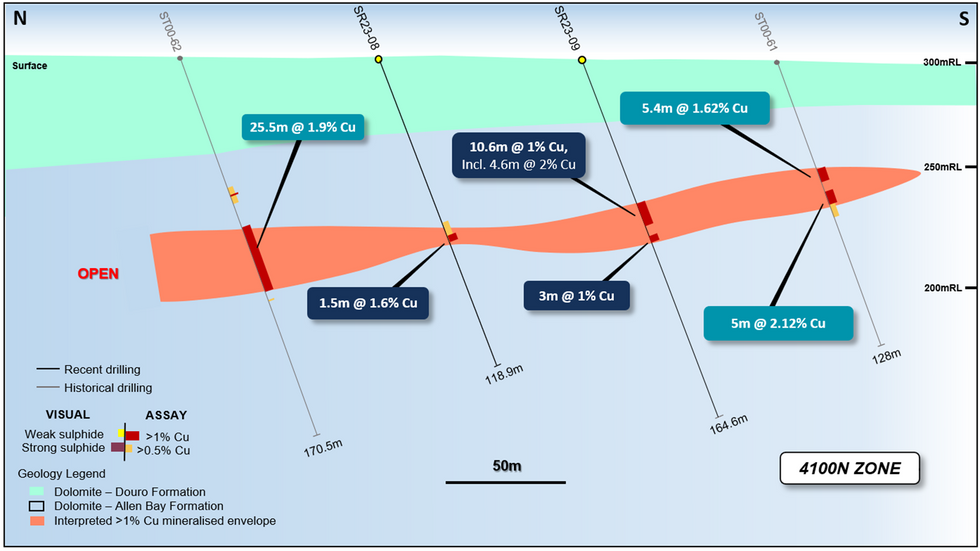
 Figure 3: Geological section view at 464,725E showing the interpreted mineralization envelope (>1% Cu) and recent drill hole assays and visual observations. Stated drill hole intersections are all core length, and true width is expected to be 60% to 95% of stated length.
Figure 3: Geological section view at 464,725E showing the interpreted mineralization envelope (>1% Cu) and recent drill hole assays and visual observations. Stated drill hole intersections are all core length, and true width is expected to be 60% to 95% of stated length.
Hole ID | From (m) | To (m) | Width | Cu % | Zn % | Ag g/t |
SR23-08 | 71.6 | 82.3 | 10.7 | 0.6 | - | 3.2 |
Including | 80.8 | 82.3 | 1.5 | 1.6 | - | 2 |
Table 3: Summary of significant drilling intersections for drill hole SR23-08 (>0.5% Cu)
Hole ID | From (m) | To (m) | Width | Cu % | Zn % | Ag g/t |
SR23-09 | 67.1 | 77.7 | 10.6 | 1 | - | 5.3 |
Including | 71.6 | 76.2 | 4.6 | 2 | - | 10.3 |
And | 82.3 | 85.3 | 3 | 1 | 6 |
Table 4: Summary of significant drilling intersections for drill hole SR23-09 (>0.5% Cu)
DRILL HOLE SR23-13 DETAILS
Drill hole SR23-13 was completed on the same section (465,050E) as drill holes SR23-03 and SR23-04 (Figure 4). The drill hole is located to the north of SR23-03 (67m (core length) @ 1.1% Cu) and was drilled to a downhole depth of 175.3m.
The drill hole confirmed the extension of the thick mineralization to the north and intersected a broad interval of strong copper sulfide mineralization with three higher-grade bands. The lower 1.5m thick band consists of very dense chalcocite veining and averages 8.2% Cu.
Importantly, SR23-13 remains open to the north in an area with significant EM anomalism.
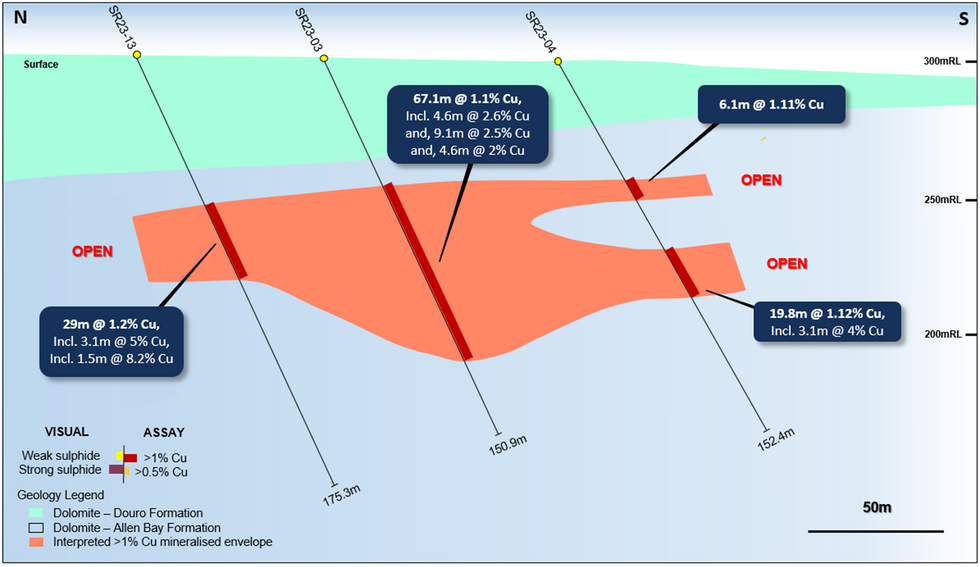
Figure 4: Geological section view at 465,050E showing the interpreted mineralization envelope (>1% Cu) and recent drill hole assays and visual observations. Stated drill hole intersections are all core length, and true width is expected to be 60% to 95% of stated length.
Hole ID | From (m) | To (m) | Width | Cu % | Zn % | Ag g/t |
SR23-13 | 62.5 | 91.5 | 29 | 1.2 | - | 3.7 |
Including | 62.5 | 64 | 1.5 | 2.9 | - | 8 |
And | 67.1 | 68.6 | 1.5 | 2.4 | - | 20 |
And | 80.8 | 82.3 | 1.5 | 2.1 | - | 5 |
And | 86.7 | 91.4 | 4.7 | 3.5 | - | 4.7 |
Including | 86.9 | 89.9 | 3 | 5 | - | 6 |
Including | 86.9 | 88.4 | 1.5 | 8.2 | - | 9 |
Table 5: Summary of significant drilling intersections for drill hole SR23-13 (>0.5% Cu)
DRILL HOLE SR23-14 and SR23-15 DETAILS
SR23-14 and SR23-15 were drilled to test continuity along the East-West main strike of the mineralization. The holes were drilled to a downhole depth of 160m and 166.1m respectively.
The drill holes have successfully confirmed the consistency of the copper mineralization between the historical sections and increased the resource confidence in the central part of the 4100N Zone.
Drill hole SR23-14 has intersected a single, very wide interval of vein and fracture-style copper sulfide mineralization with individual assays up to 4.9% Cu.
Drill hole SR23-15 also intersected a wide zone (30m) of >0.5% Cu mineralization with higher-grade bands of >1% Cu mineralization toward the base of the interval.
Hole ID | From (m) | To (m) | Width | Cu % | Zn % | Ag g/t |
SR23-14 | 61 | 86.9 | 25.9 | 1.3 | - | 2.4 |
Including | 76.2 | 85.3 | 9.1 | 2.1 | - | 3.8 |
Including | 82.3 | 85.3 | 3 | 3.7 | - | 5.5 |
Table 6: Summary of significant drilling intersections for drill hole SR23-14 (>0.5% Cu)
Hole ID | From (m) | To (m) | Width | Cu % | Zn % | Ag g/t |
SR23-15 | 44.2 | 74.7 | 30.5 | 0.5 | - | 1.3 |
Including | 44.2 | 47.2 | 3 | 1.3 | - | 2 |
And | 65.5 | 68.6 | 3.1 | 1.3 | - | 2.5 |
And | 71.6 | 73.2 | 1.6 | 1.3 | - | 3 |
Table 7: Summary of significant drilling intersections for drill hole SR23-15 (>0.5% Cu)
4100N ZONE - TIP OF THE ICEBERG?
The new drill hole data at the 4100N Zone is helping to further the understanding of the geological setting and mineralization processes of the Storm copper system. The drilling is revealing a laterally extensive zone of mineralization that displays many of the features of a typical sediment hosted copper deposit, including multiple stacked copper horizons. The recent gravity survey data has highlighted a large and dense body underneath the 4100N Zone (see June 9, 2023 news release) which is interpreted to potentially represent a larger accumulation of copper sulfides (Figure 5).
Importantly, the geology of the 4100N displays marked similarities to that observed in drilling that has tested deeper parts of the system. Drill hole ST22-10, drilled to the west and below the stratigraphic level of the 4100N Zone, targeted a large EM anomaly and intersected 68 m of a typical sediment hosted mineral assemblage including chalcopyrite, pyrite, sphalerite, and galena. At the 4100N Zone and elsewhere at Storm, this mineral assemblage is located peripheral to a larger and higher-grade core dominated by chalcocite, bornite and covellite.
The geological similarities and spatial association between the 4100N Zone and ST22-10 suggest that the two types of mineralization may be related and form part of a large, stacked copper system hosted in several prospective stratigraphic horizons (Figure 6).
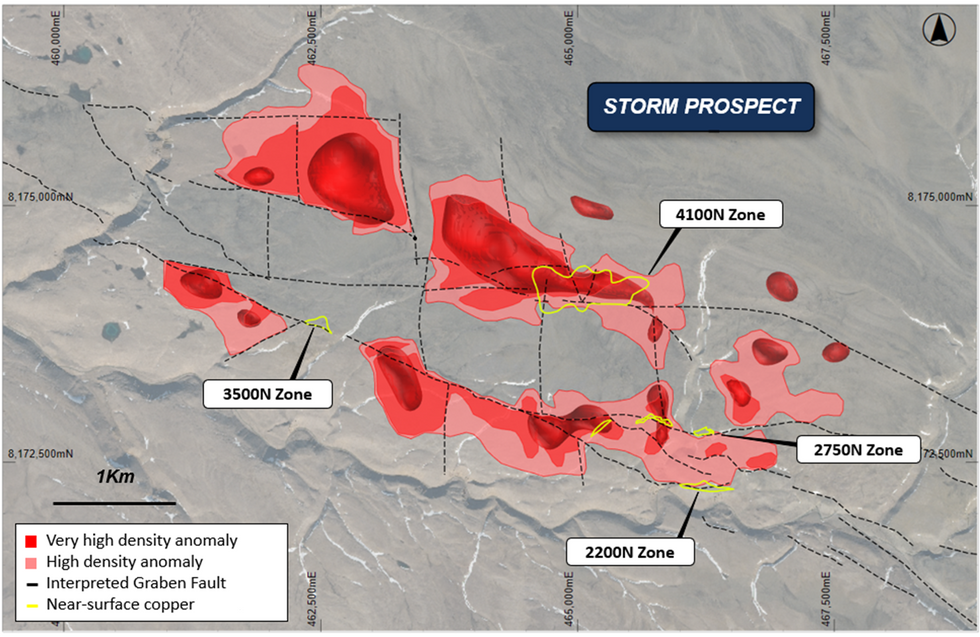
Figure 5: Gravity data interpretation map showing the 3D gravity targets, zones of known near-surface copper sulfide mineralization and major faults (overlaying topography).
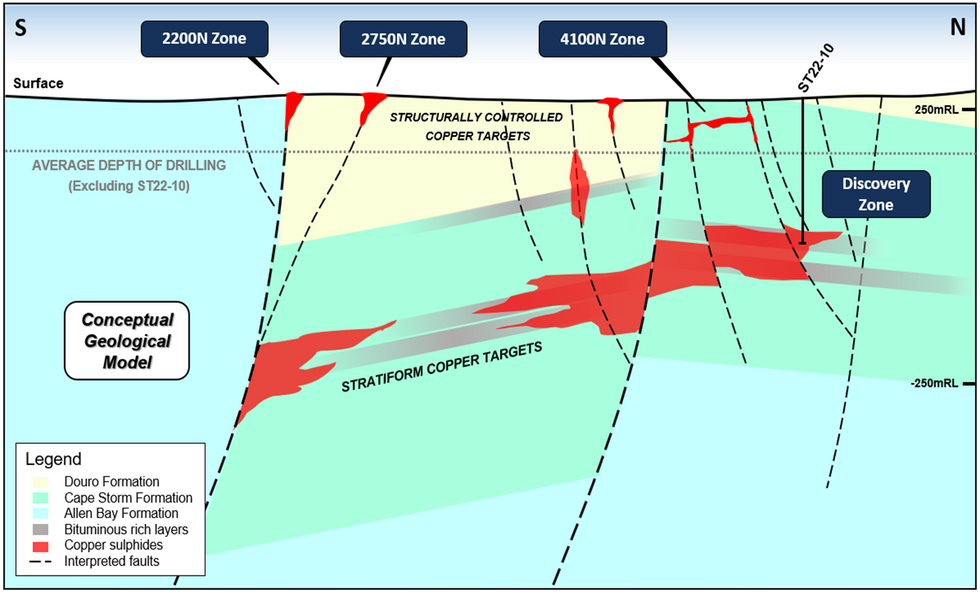
Figure 6: Conceptual geological and exploration targeting model for the Storm Project, showing depth of current drilling and conceptual location of discovery drill hole ST22-10.
EVIDENCE OF A MAJOR COPPER SYSTEM
The drilling and geophysical evidence strongly support the potential for a large-scale copper system within the Storm Project area.
The geology of the area displays all the elements required in the sediment-hosted mineralizing process: permeable carbonate rocks to act as a fluid conduit and host mineralization, hydrocarbons to reduce metal-bearing fluids and force metal precipitation, sulfur source from bitumen and sour gas, proximity to faults known to be an effective source for plumbing, all within a favourable structural setting.
A distinct zonation of metal and mineralogy is also observed at Storm. The zonation appears as a large copper-rich core (chalcocite, bornite and covellite) that gives way laterally and vertically to thinner peripheral zones of copper-iron (chalcopyrite), iron (pyrite), zinc (sphalerite) and minor lead (galena). This zonation provides a powerful vector for exploration.
These key features are similar to many of the world's major sediment-hosted copper systems, including the deposits of the Kalahari Copper Belt (Botswana) and Central African Copper Belt (DRC, Zambia).
PLANNED PROGRAM
- The drilling at the 4100N Zone will be followed by resource definition drilling at the 2200N and 2750N Zone, where drilling during 2022 intersected high-grade copper sulfides close to surface including 41m (core length) @ 4.18% Cu from 38m (ST22-05) downhole.
- Processing and interpretation of the MLEM data is almost complete. Drilling is being planned to follow-up any new MLEM anomalies.
- Diamond drilling has been scheduled to test the large geophysical copper targets below the near-surface mineralization defined in recent EM and gravity surveys.
- Sorting, beneficiation and process optimisation continues on a range of mineralization styles.
- An environmental baseline survey will begin in the Storm area during Q3 2023.
About the Storm Copper and Seal Zinc-Silver Projects, Nunavut
The Nunavut property consists of 173 contiguous mining claims covering an area of approximately 219,257 hectares on Somerset Island, Nunavut, Canada. The Storm Project comprises both the Storm Copper Project, a high-grade sediment-hosted copper discovery (intersections including 110m* @ 2.45% Cu from surface and 56.3m* @ 3.07% Cu from 12.2m) as well as the Seal Zinc Deposit (intersections including 14.4m* @ 10.58% Zn, 28.7g/t Ag from 51.8m and 22.3m* @ 23% Zn, 5.1g/t Ag from 101.5m). Additionally, there are numerous underexplored and undrilled targets within the 120-kilometre strike length of the mineralized trend, including the Tornado copper prospect where 10 grab samples yielded >1% Cu up to 32% Cu in gossans.
Storm Discovery and Historical Work
High-grade copper mineralization was discovered at Storm in the mid-1990s by Cominco geologists conducting regional zinc exploration around their then-producing Polaris lead-zinc mine. A massive chalcocite boulder found in a tributary of the Aston River in 1996 was traced to impressive surface exposures of broken chalcocite mineralization at the surface for hundreds of metres strike length at what became named the 2750N, 2200N, and 3500N Zones. Subsequent seasons of prospecting, geophysics and over 9,000 m of drilling into the early 2000s confirmed a significant amount of copper mineralization below the surface exposures as well as making the blind discovery of the 4100N Zone, a large area of copper mineralization with no surface exposure.
Following the merger of Cominco with Teck in 2001 and the closure of the Polaris Mine, the Storm claims were allowed to lapse in 2007. Commander Resources re-staked the property in 2008 and flew a helicopter-borne VTEM survey in 2011 but conducted no additional drilling. Aston Bay subsequently entered into an earn-in agreement with Commander and consolidated 100% ownership in 2015. Commander retains a 0.875% Gross Overriding Royalty in the area of the original Storm claims.
In 2016 Aston Bay entered into an earn-in agreement with BHP, who conducted a 2,000-station soil sampling program and drilled 1,951m of core in 12 diamond drill holes, yielding up to 16m* @ 3.1% Cu. BHP exited the agreement in 2017. Aston Bay conducted a property-wide airborne gravity gradiometry survey in 2017 and drilled 2,913m in nine core holes in the Storm area in 2018 yielding a best intercept of 1.5m* @ 4.39% Cu and 20.5m* @ 0.56% Cu.
Agreement with American West Metals
An earn-in agreement for the Storm and Seal properties was signed with American West Metals in March 2021. Under the terms of the agreement, an expenditure of C$10m will earn 80% ownership of the property for American West. Aston Bay is carried for all expenditures to the completion of a feasibility study and production decision. If Aston Bay chooses not to participate and is diluted below 10% ownership, the ownership converts to a 2% Net Smelter Royalty, half of which is purchasable by American West for C$5m at first production. Aston Bay received a cash payment of C$500,000 on signing.
Recent Work
American West completed a fixed loop electromagnetic (FLEM) ground geophysical survey in 2021 that yielded several new subsurface conductive anomalies. A total of 1,534m were drilled in 10 diamond drill holes in the 2022 season, yielding several impressive near-surface intercepts including 41m* @ 4.1% Cu as well as 68m of sulfide mineralization associated with a deeper conductive anomaly.
In April 2022 results of beneficiation studies demonstrated that a mineralized intercept grading 4% Cu from the 4100N area could be upgraded to a 54% Cu direct ship product using standard sorting technology. Further beneficiation studies are ongoing.
In April 2023 American West embarked on a spring delineation drilling program using a helicopter-portable reverse circulation (RC) drill rig as well as gravity and moving loop electromagnetic (MLEM) ground geophysical programs. Results from the programs are in process and are released as they come available.
A summer 2023 program plans further delineation drilling of the near-surface high-grade copper zones to advance them toward maiden resource reports by late 2023. Diamond drilling is planned to test new high-priority gravity targets and environmental baseline studies will be initiated.
*Stated drill hole intersections are all core length, and true width is expected to be 60% to 95% of core length.
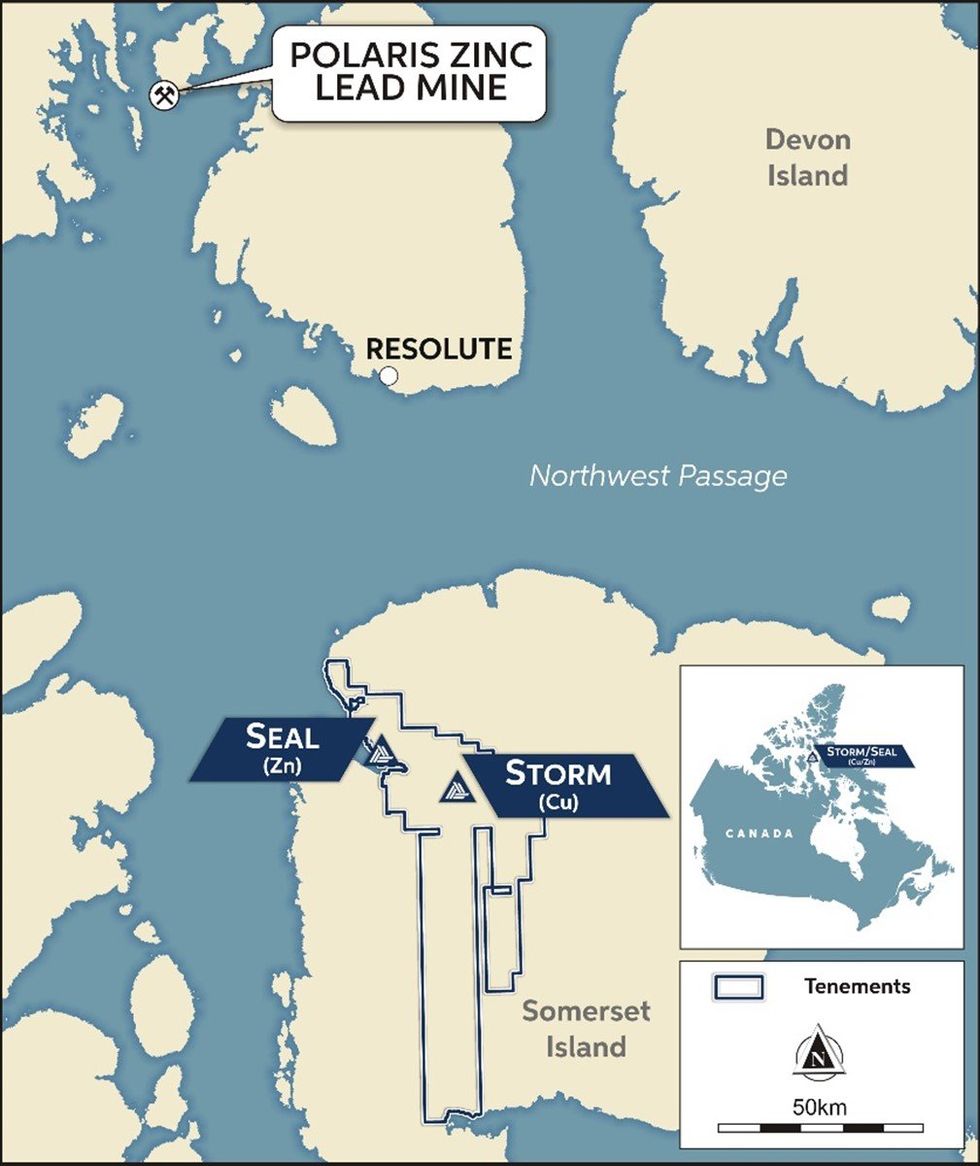
Figure 7: Storm Copper Project, Location Map.
QA/QC Protocols
The analytical work reported herein was performed by ALS Global ("ALS"), Vancouver Canada. ALS is an ISO-IEC 17025:2017 and ISO 9001:2015 accredited geoanalytical laboratory and is independent of Aston Bay Holdings Ltd., American West Metals Limited, and the QP. Reverse Circulation drilling was completed by Northspan Explorations Ltd using a Hornet helicopter-portable drilling rig. The sampling interval for reverse circulation drilling is five feet, with sampling and geological intervals determined visually by geologists with relevant experience. Samples were subject to crushing at a minimum of 70% passing 2 mm, followed by pulverizing of a 250-gram split to 85% passing 75 microns. Samples were subject to 33 element geochemistry by four-acid digestion and inductively coupled plasma atomic emission spectroscopy (ICP-AES) to determine concentrations of copper, silver, lead, zinc, and other elements (ALS Method ME-ICP61a). Overlimit values for copper (>10%) and were analyzed via four-acid digestion and ICP-AES (ALS Method Cu-OG62).
Aston Bay Holdings Ltd. and American West Metals Limited followed industry standard procedures for the work carried out on the Storm Project, incorporating a quality assurance/quality control (QA/QC) program. Blank, duplicate, and standard samples were inserted into the sample sequence and sent to the laboratory for analysis. No significant QA/QC issues were detected during review of the data. Aston Bay Holdings Ltd. and American West Metals Limited are not aware of any drilling, sampling, recovery, or other factors that could materially affect the accuracy or reliability of the data referred to herein.
Qualified Person
Michael Dufresne, M.Sc., P.Geol., P.Geo., is a qualified person as defined by National Instrument 43-101 and has reviewed and approved the scientific and technical information in this press release.
About Aston Bay Holdings
Aston Bay is a publicly traded mineral exploration company exploring for high-grade copper and gold deposits in Virginia, USA, and Nunavut, Canada. The Company is led by CEO Thomas Ullrich with exploration in Virginia directed by the Company's advisor, Don Taylor, the 2018 Thayer Lindsley Award winner for his discovery of the Taylor Pb-Zn-Ag Deposit in Arizona. The Company is currently exploring the high-grade Buckingham Gold Vein in central Virginia and is in advanced stages of negotiation on other lands with high-grade copper potential in the area.
The Company is 100% owner of the Storm Project property, which hosts the Storm Copper Project and the Seal Zinc Deposit and has been optioned to American West Metals Limited.
About American West Metals Limited
AMERICAN WEST METALS LIMITED (ASX: AW1) is an Australian clean energy mining company focused on growth through the discovery and development of major base metal mineral deposits in Tier 1 jurisdictions of North America. Our strategy is focused on developing mines that have a low-footprint and support the global energy transformation. Our portfolio of copper and zinc projects in Utah and Canada include significant existing resource inventories and high-grade mineralization that can generate robust mining proposals. Core to our approach is our commitment to the ethical extraction and processing of minerals and making a meaningful contribution to the communities where our projects are located.
Led by a highly experienced leadership team, our strategic initiatives lay the foundation for a sustainable business which aims to deliver high-multiplier returns on shareholder investment and economic benefits to all stakeholders.
For further information on American West, visit: www.americanwestmetals.com.
FORWARD-LOOKING STATEMENTS
Statements made in this news release, including those regarding the Option Agreement, grant of the Option and the expected closing date, American West's interest in the Storm Project and its other acquisitions and plans, plans for the upcoming field season, management objectives, forecasts, estimates, expectations, or predictions of the future may constitute "forward-looking statement", which can be identified by the use of conditional or future tenses or by the use of such verbs as "believe", "expect", "may", "will", "should", "estimate", "anticipate", "project", "plan", and words of similar import, including variations thereof and negative forms. This press release contains forward-looking statements that reflect, as of the date of this press release, Aston Bay's expectations, estimates and projections about its operations, the mining industry and the economic environment in which it operates. Statements in this press release that are not supported by historical fact are forward-looking statements, meaning they involve risk, uncertainty and other factors that could cause actual results to differ materially from those expressed or implied by such forward-looking statements. Although Aston Bay believes that the assumptions inherent in the forward-looking statements are reasonable, undue reliance should not be placed on these statements, which apply only at the time of writing of this press release. Aston Bay disclaims any intention or obligation to update or revise any forward-looking statement, whether as a result of new information, future events or otherwise, except to the extent required by securities legislation.
For more information contact:
Thomas Ullrich, Chief Executive Officer
thomas.ullrich@astonbayholdings.com
(416) 456-3516
Sofia Harquail, IR and Corporate Development
sofia.harquail@astonbayholdings.com
(647) 821-1337
BAY:CA

Sign up to get your FREE
Aston Bay Holdings Investor Kit
and hear about exciting investment opportunities.
- Corporate info
- Insights
- Growth strategies
- Upcoming projects
GET YOUR FREE INVESTOR KIT
The Conversation (0)
30 June 2022
Aston Bay Holdings
Aston Bay Holdings Ltd is an exploration-stage company. It is engaged in the exploration and development of gold and base metal deposits in Virginia, USA and Nunavut, Canada. Its projects are Buckingham Gold property, Virginia Gold Belt, Polymetallic Base, and Precious metals, Storm Copper Project, and Seal Zinc deposit.
Aston Bay Holdings Ltd is an exploration-stage company. It is engaged in the exploration and development of gold and base metal deposits in Virginia, USA and Nunavut, Canada.
28 August
Empire Metals Limited Announces Breakthrough in Process Development
Empire Metals Limited, the AIM-quoted and OTCQB-traded exploration and development company, is pleased to report significant progress in metallurgical testwork at its Pitfield Project in Western Australia ('Pitfield' or the 'Project'). These results confirm that the weathered ore at Pitfield can be processed using conventional separation and refining techniques, delivering industry-leading recoveries and a high-purity titanium dioxide (TiO₂) product.
Highlights
- Exceptional flotation performance: Recoveries of 77% (rougher stage) and 90% (cleaning stage) from fine, weathered ore samples.
- Outstanding leach results: Direct acid bake and hot-water leach achieved 98% titanium dissolution, leaving inert quartz residues.
- High recoveries: Overall titanium recovery from flotation feed to final product is circa 67% and expected to improve with further optimisation of the mineral separation stages.
- High-purity final product: TiO₂ grading 99.25% with negligible impurities, suitable for titanium sponge metal or pigment production.
- Cost and environmental advantages: Low Fe₂O₃ (~5%) reduces acid consumption, minimises waste, and supports higher recoveries over typical ilmenite feedstock processing.
- Simplified, expedited development pathway: Amenability to standard mineral separation eliminates the need for a costly bespoke demonstration plant, enabling a lower-cost continuous pilot programme using accredited commercial laboratories.
Shaun Bunn, Managing Director, said:
"These results mark a step change in Pitfield's development. We now have clear evidence that the ore is ideally suited to conventional mineral separation and refining, producing a high-purity titanium product with strong recoveries. This sets Pitfield apart from ilmenite-based projects, which typically face lower recoveries, higher costs, and significant environmental challenges.
"Pitfield already stands out for its exceptional scale, continuity of high-grade near-surface mineralisation, and Tier 1 location with access to infrastructure. With this breakthrough in process development, we can now demonstrate a highly efficient and environmentally responsible route to producing multiple high-value titanium products."
Metallurgical Testwork Summary
Empire has committed substantial financial resources to developing a metallurgical flowsheet that can economically extract titanium and produce a high value titanium product: such as TiO2 pigments, and/or feedstock for the TiO2 pigment or titanium sponge metals industries.
The approach to flowsheet development has included:
- Extensive mineralogical investigations on exploration samples, testwork feed samples and testwork products
- Wide ranging literature reviews, including industry and cross-industry research
- Idea generation and testing of concepts and conditions in the laboratory
- A fast-tracked separate work programme to prove that an impurity free high grade product can be made from samples taken at Pitfield.
Initial mineralogical and metallurgical testwork was undertaken on the fresh, titanite-rich bedrock mineralisation at Pitfield and returned encouraging results. Following the identification of the extensive in-situ weathered cap, which independently represents a generational-scale mining opportunity, subsequent testwork programmes have been directed toward this material. The weathered cap contains mainly anatase and rutile, and is distinguished by its soft, friable texture, elevated titanium grades, and near-surface exposure which offer significant advantages from both a mining and processing perspective.
Empire has employed two full time process engineers to work on the process flowsheet development, both of whom have extensive experience in mineral separation and elemental extraction (hydrometallurgy). In addition, Empire has contracted with two titanium expert consultants, each of which has over 40 years' experience in the industry. The process development programme is also supported by further specialist input from the technical team at Strategic Metallurgy, scientists from Federal Government agencies and process engineers from local Engineering & Process Design Consultants.
Testwork results achieved to date are encouraging and support the conceptual process flowsheet that was announced 4 September 2024 "Positive Results Achieved from Initial Processing Testwork on Pitfield Titanium Ore" (refer Figure 1).

Figure 1. Conceptual Process Flowsheet.
Recent testwork has been focused on the fine, saprolite ores from the Thomas prospect. Testwork results to date suggest that Empire can expect to achieve an overall recovery of circa 65-75%, and produce a high-purity, +99% TiO2 product. This is based on early stage testwork with limited optimisation, and the success to date is a good indicator that the Pitfield ores are non-refractory and free of deleterious contaminants that affect product quality (such as U, Th, Cr, P and V).
Whilst it is difficult to provide comparable projects to Pitfield, given its scale, grade and unique ore characteristics, the processing route being evaluated for Pitfield has similar stages to that found in the well-established heavy mineral sands industry. For instance, the ilmenite within the mineral sands is first separated (by gravity and magnetics) and the ilmenite concentrates are then beneficiated by a combination of reduction roast and leach to produce synthetic rutile. This in turn becomes feedstock to the TiO2 pigment or Ti sponge metal producers, both of which use strong oxidants (Cl gas or sulphuric acid) and high temperatures to transform the feedstock into pigments or TiCl4.
The whole process of recovering titanium from ilmenite; concentrating, beneficiation and then transforming it into a high-purity product is inefficient (generally low recoveries), expensive (high energy consumption and expensive consumables) and environmentally unfriendly (substantial Fe residues to dispose of from the breakdown of the ilmenite). The unique ore characteristics of Pitfield provide an opportunity to design a new processing route that is more efficient, lower cost and has greater optionality over the products it can produce than that currently experienced by the ilmenite processors, who account for 95% of the titanium supply chain.
Metallurgical Samples
Samples being used for the testwork programme have been collected from drilling programmes conducted across the deposit. These include drill core samples from diamond drilling, and bulk samples from air core drilling programmes. Samples have been collected from both exploration targets - Cosgrove ('COS') and Thomas ('TOM'). Separate Saprolite ('SAP') and Weathered Sandstone ('WS') zones have been identified. Some of the testwork samples are a blend of the two zones and some have been kept separate to understand the performance of the weathering profile.
Mineralogy
A number of mineralogy techniques are being used to develop the understanding of the Pitfield mineralogy and morphology. SEM based TIMA analysis has been undertaken at Automated Mineralogy Incubator (AMI) on exploration samples, testwork feed samples and testwork products.
|
Figure 2. Mineralogist at AMI discussing Pitfield TIMA analysis results with Empire Metallurgist
Key information collected from TIMA analysis on testwork feed samples and exploration samples includes the titanium and gangue minerals present, the grain sizes, and the mineral association.
Testwork product samples have also been analysed using TIMA to understand the deportment of the different titanium minerals and effectiveness of each of the processing steps. More than 100 samples have been analysed using TIMA, including geology samples, testwork feed samples and testwork products.
XRD analysis has also been used on a range of samples. This has been used to help with mineral identification that SEM cannot determine - such as the crystal structure of titanium oxide minerals, identifying them as either anatase or rutile.
Microprobe analysis, at CSIRO in Melbourne, has been used on a small number of samples: to measure impurities in titanium minerals in particular.
Testwork - Flowsheet Development
Some early testwork programmes were undertaken using fresh mineralisation from Pitfield, however once an understanding of the mineralogy and volume of the weathered zone was developed, the focus shifted to this material.
Comminution and Mineral Separation
Several comminution tests have been completed on drillcore samples to investigate potential for low energy input comminution such as scrubbers and log washers. The optimal regrind liberation size range and the energy input required, which appears to be very low, continues to be investigated.
A wide range of unit processes are being investigated for mineral separation utilising whole-of-ore samples as well as separated coarse and fine fraction samples.
Testwork on the coarse fraction has focused on gravity and enhanced gravity separation, testing shaking tables, spirals, and a Multi Gravity Separator (MGS). The shaking table tests and MGS tests were completed at batch scale (~5-20kg), whilst the spiral tests were undertaken on a much larger, bulk scale (~300-600kg).
Testwork on the fine fraction looked at enhanced gravity (MGS) and froth flotation. A range of flotation reagents and conditions are being tested. Relevant examples exist in the non-sulphide flotation industry, including anatase flotation from kaolin clay minerals in the kaolinite industry.
Whole-of-ore testwork is in the planning stages for comparison against gravity separation performance. This testwork will focus on grinding, flotation and then further treatment of the flotation concentrate assessing a number of different separation processes.
Key results to date include:
· Fine fraction "rougher" flotation on a TOM SAP sample has achieved 67- 77% TiO2 recovery and up to 19% TiO2 concentrate grade. Similar recovery performance was achieved on a COS WS sample fines fraction with a "rougher" flotation recovery of 68%.
· Cleaner tests on rougher concentrate from the TOM SAP rougher flotation test achieved a 90% stage recovery at 32%TiO2 concentrate grade. This equates to an overall float recovery of circa 70%.
· Bulk scrubber testwork on TOM SAP sample resulted in 51% of the mass and 72% of the contained TiO2 to the fines fraction, using a hydro cyclone. Similar results were seen on a smaller scale scrubber test using drillcore material, with 53% of the mass and 66% of the TiO2 reporting to the fines fraction, using a 38µm screen.
|
| ||
Figure3. (L-R): Bulk Scrubber test in progress at AML, Batch slimes fraction rougher flotation test at ALS.
Elemental Extraction and Product Finishing
A wide range of concepts are being explored for extraction of titanium from the mineral concentrate. These range from conventional processes, already applied in the titanium industry or other comparable industries, to more novel processes that have been developed through laboratory research and pilot scale testing.
A base case of sulphuric acid bake water leach, followed by titanium hydrolysis and calcination has been tested by Empire. This is based on the conventional sulphate route for TiO2 pigment production, which is usually applied to ilmenite concentrates. A range of other lixiviants and decomposition and leach conditions have been identified and are planned to be tested as part of the ongoing development programme.
Product finishing testwork aims to take titanium from the leach solutions and produce a final product. It is closely tied to the elemental extraction, so in some cases is being tested as part of that testwork programme. There is a range of product options: separate research testwork is being undertaken to develop and understanding of the various TiO2 pigments and Ti chemicals that Pitfield can produce and the markets in which these products are required.
Around 15 leach tests have been completed to date, including five product finishing tests. A number of product process options are as yet untested: further testwork is budgeted and is currently in the planning stage.
Elemental extraction results achieved to date include:
- Acid bake water leach tests on rougher flotation concentrate have achieved 98% TiO2 extraction to the liquor phase.
- Titanium hydrolysis and calcination has been successfully applied to the leach liquor after iron conversion, producing a low-impurity TiO2 product containing 99.25% TiO2.
- Recovery in the hydrolysis stage requires further testwork as the conditions applied in the tests and has not yet been optimised. Hydrolysis is a standard process used in sulphate pigment industry, and high recoveries (greater than 95%) are achieved on a commercial scale.
|
Figure 4. Elemental Extraction testwork (L-R): Acid-Concentrate mixing pre-acid bake, Acid bake product, initial stages of water leach, water leach residue and filtrate.
Product Potential
A fast-tracked separate work programme was undertaken to determine whether an impurity-free high grade product could be made from samples taken at Pitfield. The sample was processed through scrubbing, gravity separation, flotation, acid bake/water leach, impurity removal, titanium hydrolysis and calcination. The flowsheet used and conditions selected were based on industrial examples and literature. This work achieved a product grade of 99.25% TiO2: impurity levels, particularly colorformers which impact negatively on pigment quality, were below detection limits or very low. (Announcement "Exceptional High-Purity TiO2 Product Achievement" 9 June 2025).
Further work is ongoing to understand the TiO2 pigment market, optimise the test conditions and also understand the alternative product options, such as TiCl4 (the feedstock for making titanium sponge metal) or other titanium chemicals.

Figure5. Purification and Product finishing testwork (L-R): titanyl sulphate solution from leaching stage, hydrated TiO2 produced from hydrolysis, and the calcined TiO 2 product
Future metallurgical testwork
Empire has committed significant resources to enable the process flowsheet development programme to continue to proceed at pace. This includes not only the allocation of several full time Empire technical staff but also the use of various industry specialists who support the Empire team in managing the necessary metallurgical testwork and research programmes.
Over the coming months the Company will focus on optimising the mineral separation stages to further improve the flotation and gravity concentrate grades and recovery. Bulk metallurgical testwork has commenced, utilising large scale scrubbing, gravity and flotation test equipment at local mineral processing laboratories. This testwork will produce significant quantities of titanium mineral concentrates: allowing the testing of multiple downstream beneficiation options aimed at defining the optimal hydrometallurgical processing route.
Finished product optimisation, through research and laboratory testwork, is continuing and is aimed at further refining the +99% titanium product already achieved to date, looking at alternative titanium products for marketing purposes.
The next steps for the mineral separation flowsheet development will be further optimisation of the chemistry and conditions, larger scale batch testwork and then continuous piloting can be undertaken at a laboratory scale. Testwork to date has shown the Pitfield weathered ores amenability to conventional mineral separation, beneficiation and refining techniques, and this avoids the need to build a bespoke, demonstration plant. A simpler and lower cost continuous pilot plant operation can be established, utilising local, internationally accredited commercial metallurgical laboratories.
The Company aims to complete the bench and large scale batch metallurgical testwork phase by Q1 2026, which is when it expects to move toward continuous piloting of the process in order to provide the critical technical information for the development of a commercial process flowsheet and to enable the supply of bulk product samples to prospective end users.
The Pitfield Titanium Project
Located within the Mid-West region of Western Australia, near the northern wheatbelt town of Three Springs, the Pitfield titanium project lies 313km north of Perth and 156km southeast of Geraldton, the Mid West region's capital and major port. Western Australia is a Tier 1 mining jurisdiction, with mining-friendly policies, stable government, transparency, and advanced technology expertise. Pitfield has existing connections to port (both road & rail), HV power substations, and is nearby to natural gas pipelines as well as a green energy hydrogen fuel hub, which is under planning and development (refer Figure 3).

Figure 3. Pitfield Project Location showing theMid-West Region Infrastructure and Services
Competent Person Statement
The scientific and technical information in this report that relates to process metallurgy is based on information reviewed by Ms Narelle Marriott, an employee of Empire Metals Australia Pty Ltd, a wholly owned subsidiary of Empire. Ms Marriott is a member of the AusIMM and has sufficient experience relevant to the style of mineralisation and type of deposit under consideration and to the activity being undertaken to qualify as a Competent Person as defined in the JORC Code 2012. Ms. Marriott consents to the inclusion in this announcement of the matters based on their information in the form and context in which it appears.
The technical information in this report that relates to the Pitfield Project has been compiled by Mr Andrew Faragher, an employee of Empire Metals Australia Pty Ltd, a wholly owned subsidiary of Empire. Mr Faragher is a Member of the Australian Institute of Mining and Metallurgy. Mr Faragher has sufficient experience that is relevant to the style of mineralisation and type of deposit under consideration and to the activity being undertaken to qualify as a Competent Person as defined in the 2012 Edition of the 'Australasian Code for Reporting of Exploration Results, Mineral Resources and Ore Reserves'. Mr Faragher consents to the inclusion in this release of the matters based on his information in the form and context in which it appears.
Market Abuse Regulation (MAR) Disclosure
Certain information contained in this announcement would have been deemed inside information for the purposes of Article 7 of Regulation (EU) No 596/2014, as incorporated into UK law by the European Union (Withdrawal) Act 2018, until the release of this announcement.
**ENDS**
For further information please visit www.empiremetals.co.uk or contact:
Empire Metals Ltd Shaun Bunn / Greg Kuenzel / Arabella Burwell | Tel: 020 4583 1440 |
S. P. Angel Corporate Finance LLP (Nomad & Broker) Ewan Leggat / Adam Cowl | Tel: 020 3470 0470 |
Shard Capital Partners LLP (Joint Broker) Damon Heath / Erik Woolgar | Tel: 020 7186 9950 |
St Brides Partners Ltd (Financial PR) Susie Geliher / Charlotte Page | Tel: 020 7236 1177 |
About Empire Metals Limited
Empire Metals is an AIM-listed and OTCQB-traded exploration and resource development company (LON: EEE) with a primary focus on developing Pitfield, an emerging giant titanium project in Western Australia.
The high-grade titanium discovery at Pitfield is of unprecedented scale, with airborne surveys identifying a massive, coincident gravity and magnetics anomaly extending over 40km by 8km by 5km deep. Drill results have indicated excellent continuity in grades and consistency of the mineralised beds and confirm that the sandstone beds hold the higher-grade titanium dioxide (TiO₂) values within the interbedded succession of sandstones, siltstones and conglomerates. The Company is focused on two key prospects (Cosgrove and Thomas), which have been identified as having thick, high-grade, near-surface, bedded TiO₂ mineralisation, each being over 7km in strike length.
An Exploration Target* for Pitfield was declared in 2024, covering the Thomas and Cosgrove mineral prospects, and was estimated to contain between 26.4 to 32.2 billion tonnes with a grade range of 4.5 to 5.5% TiO2. Included within the total Exploration Target* is a subset that covers the weathered sandstone zone, which extends from surface to an average vertical depth of 30m to 40m and is estimated to contain between 4.0 to 4.9 billion tonnes with a grade range of 4.8 to 5.9% TiO2.
The Exploration Target* covers an area less than 20% of the overall mineral system at Pitfield which demonstrates the potential for significant further upside.
Empire is now accelerating the economic development of Pitfield, with a vision to produce a high-value titanium metal or pigment quality product at Pitfield, to realise the full value potential of this exceptional deposit.
The Company also has two further exploration projects in Australia; the Eclipse Project and the Walton Project in Western Australia, in addition to three precious metals projects located in a historically high-grade gold producing region of Austria.
*The potential quantity and grade of the Exploration Target is conceptual in nature. There has been insufficient exploration to estimate a Mineral Resource and it is uncertain if further exploration will result in the estimation of a Mineral Resource.
This information is provided by RNS, the news service of the London Stock Exchange. RNS is approved by the Financial Conduct Authority to act as a Primary Information Provider in the United Kingdom. Terms and conditions relating to the use and distribution of this information may apply. For further information, please contact rns@lseg.com or visit www.rns.com.
Click here to connect with Empire Metals (OTCQB:EPMLF, AIM:EEE) to receive an Investor Presentation
Keep reading...Show less
26 August
Corazon Mining
Investor Insight
Corazon Mining Ltd presents a compelling investment case driven by a strategic pivot to WA gold exploration, capitalising on its recent acquisition of the Two Pools gold project. This acquisition offers significant near-term exploration upside, while the company retains a high-quality portfolio of base and battery metals projects, providing long-term optionality and leverage to the evolving critical minerals market. This strategy positions Corazon to deliver shareholder value through potential high-impact discovery and future project development.
Overview
Corazon Mining Ltd (ASX:CZN) is an Australian junior exploration company focused on high-quality gold and critical minerals projects in Australia and Canada.
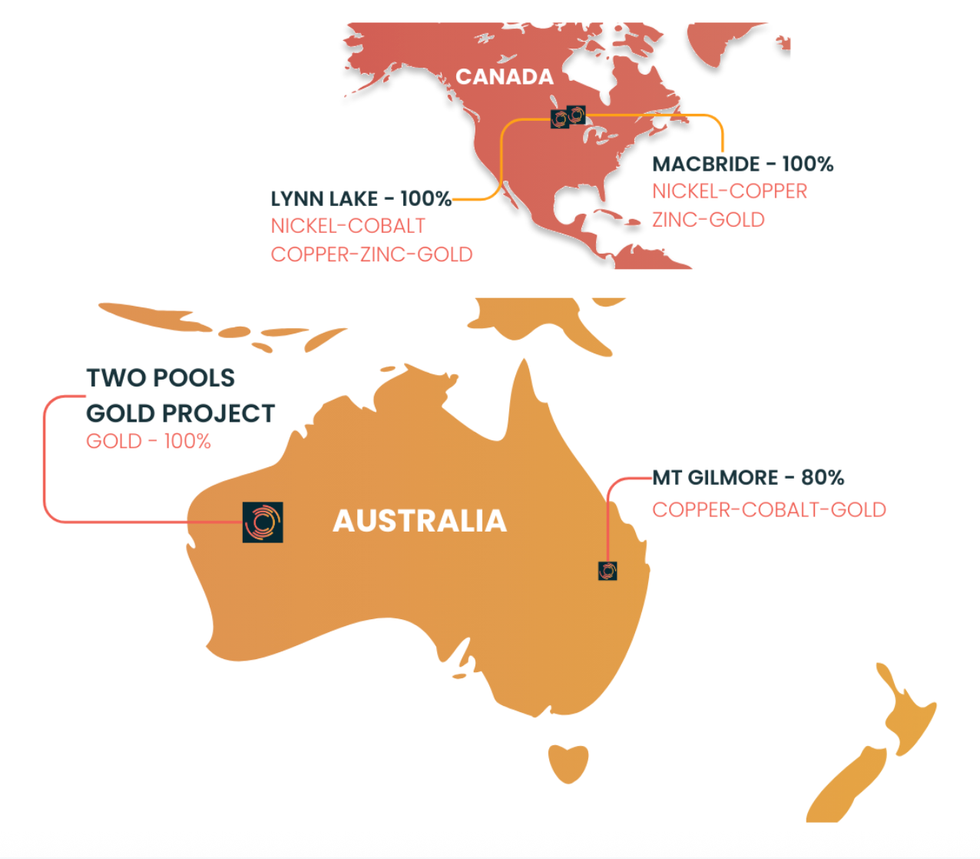
Company Highlights
- Two Pools Gold Project: The company’s primary focus is the newly acquired Two Pools Gold Project in Western Australia’s highly productive Plutonic Greenstone Belt. This underexplored tenure contains a recently identified 20km-long greenstone belt that was previously misclassified as granite.
- Confirmed High-Grade Mineralisation: Historical drilling at Two Pools has delivered standout intercepts, including 12m @ 8.89 g/t Au (incl. 3m @ 34.25 g/t Au) and 18m @ 3.89 g/t Au (incl. 4m @ 15.96 g/t Au).
- Trident-style Analogy: Drilling has confirmed mineralisation extends beneath overthrust granite, a key geological setting similar to Catalyst Metals’ nearby Trident Deposit, highlighting the potential for significant blind discoveries.
- Strategic Location: Two Pools is located just 60km from Catalyst Metals’ Plutonic Processing Plant, offering strong future development synergies
- Strategic Battery and Base Metals Portfolio: Corazon retains ownership of key projects in Canada and Australia including the MacBride Copper-Zinc-Gold Project and the historic Lynn Nickel-Copper-Cobalt sulphide camp in Manitoba, and the Mt Gilmore Copper-Cobalt-Gold project in NSW. These assets provide long-term exposure to critical metals.
- Compelling Value Proposition: Corazon offers a unique investment opportunity with a small market capitalisation but large, high-quality assets.
Key Projects
Two Pools Gold Project (Western Australia)
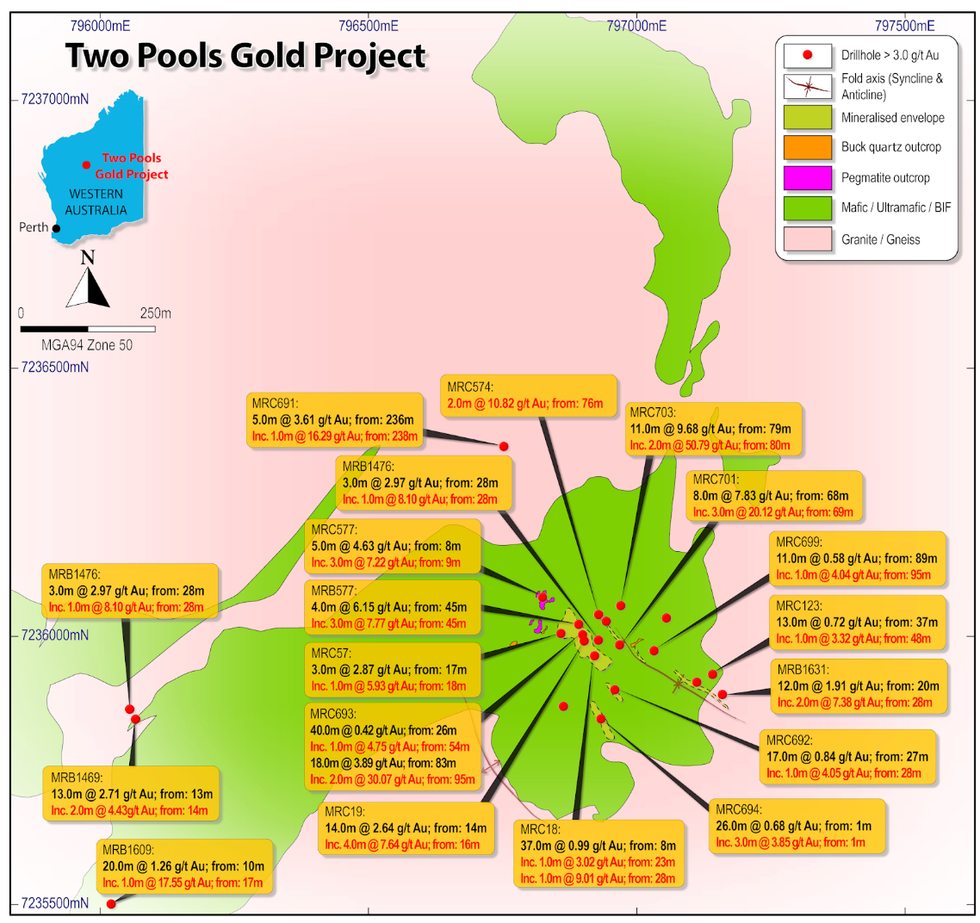
Project Highlights:
- A new, highly-prospective gold exploration project in the proven Plutonic-Marymia Greenstone Belt.
- The project covers 193km2 of underexplored tenure containing a newly identified 20km-long greenstone belt
- Historical Drilling and surface sampling have confirmed high-grade gold mineralisation, with a compelling geological setting analogous to other major deposits in the region.
Lynn Lake Base & Precious Metals (Manitoba, Canada)
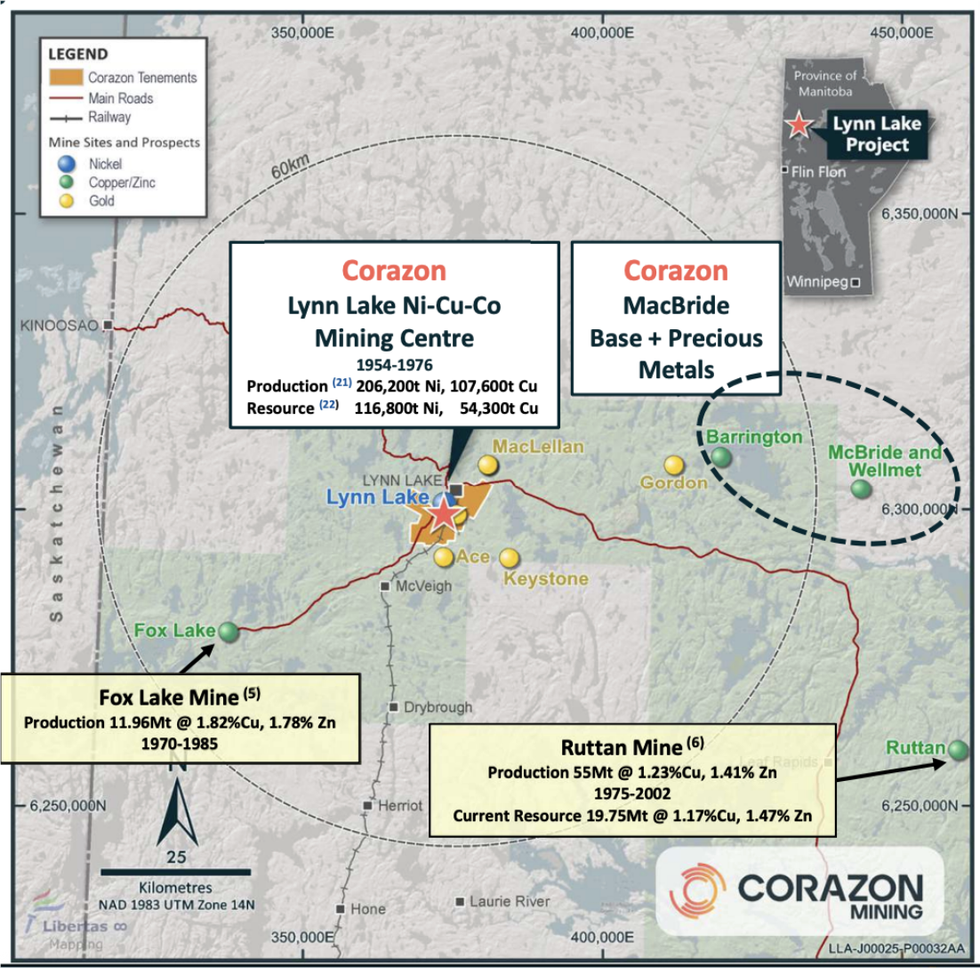
Project Highlights:
- High-quality base and precious metals asset, offering strategic, long-term value.
- MacBride Copper-Zinc-Gold Project: High-grade, near-surface mineralisation and significant exploration upside for VMS-style deposits.
- Lynn Lake Nickel-Copper-Cobalt Project: Strategic long-term asset with a significant JORC resource -total contained metal of 116,800t Ni, 54,300t Cu, 5,300t Co. The project is fully permitted and benefits from established infrastructure. Refer ASX Announcement 27 Nov 2019.
Other Projects
- Mt Gilmore Copper-Cobalt-Gold (NSW, Australia): An emerging porphyry play with potential for a significant potential copper-gold system.
Management Team
Simon Coyle – Managing Director
Simon Coyle is a mining executive with over 20 years’ experience in the resources sector, spanning across gold, iron ore, manganese and lithium. He is a graduate of the Western Australian School of Mines and has held a number of senior operational leadership roles across both private and publicly listed companies.
Most recently, Coyle served as CEO and president of TSXV-listed Velox Energy Materials. Prior to this, he held senior roles at Pilbara Minerals, including general manager - operations, where he was instrumental in the development and expansion of its flagship lithium project, establishing it as one of the world's leading spodumene concentrate producers. Coyle currently serves as non-executive director of Kali Metals.
Kristie Young – Non-executive Chair
Kristie Young is a professional Board Director who began her career as a mining engineer in the mid 90’s across both underground and open cut operations (incl. Hamersley Iron, Mt Isa Mines, Plutonic Gold, New Hampton Goldfields, Surpac), feasibility studies and project evaluation. She holds a BEng(Mining) Hons from the University of Queensland.
Over 25 years’ industry experience, including business development director roles with both EY and PwC. She brings more than 15 years’ experience on boards and committees and currently serves as a non-executive director of Brazilian Rare Earths (ASX:BRE), Livium (ASX:LIT), Tasmea Ltd (ASX:TEA), and MinEx CRC.
She is a Fellow of the AusIMM and a graduate and Fellow of the AICD.
Scott Williamson – Non-executive Director
Scott Williamson is a highly experienced mining engineer with an Engineering and Commerce degree from the West Australian School of Mines and Curtin University. With more than 20 years of experience spanning technical and corporate roles in the mining and finance sectors, he brings a wealth of industry expertise and strategic insight. A proven leader in business development, Scott has extensive experience in equity capital markets, complementing his strong technical skill set.
Currently, he serves as managing director of Blackstone Minerals and non-executive Director of Leeuwin Metals.
Scott also holds a WA First Class Mine Manager's Certificate and is a member of the Australasian Institute of Mining and Metallurgy.
Robert Orr – Company Secretary and Chief Financial Officer
Robert Orr manages Corazon's financial operations and corporate governance, ensuring compliance and effective financial management.
Keep reading...Show less
25 August
Trump's Copper Tariffs: Market Impact and How to Invest
Tariffs have been central to Donald Trump’s presidency even before he assumed office at the start of 2025.
From his perspective, levies on nearly all US imports are meant to balance a trade deficit with major partners, including Canada, Mexico, the EU and the UK, while stimulating domestic production in key sectors.
Trump has put forward other reasons for tariffs as well, saying he wants to stem the flow of illegal drugs and immigration, and mentioning broader national security concerns. How effective tariffs would be at controlling these issues is unclear, but they have sown uncertainty and chaos through global financial markets.
In the copper sector, tariff turmoil has created price volatility and left investors wondering how to position.
Trump's copper tariffs cause price turmoil
On February 25, not long after taking office for the second time, Trump initiated an investigation into copper's national security implications under Section 232 of the Trade Expansion Act of 1962.
Further details came months later, when the president provided an update on on July 8.
“I believe the tariff on copper, we're going to make 50 percent,” Trump said during a White House cabinet meeting.
His comments came without an official announcement, although Secretary of Commerce Howard Lutnick said the tariff could take effect by late July or early August. This lack of clarity caused copper prices on the Comex to surge as traders worked to bring the metal into the US ahead of potential levies.
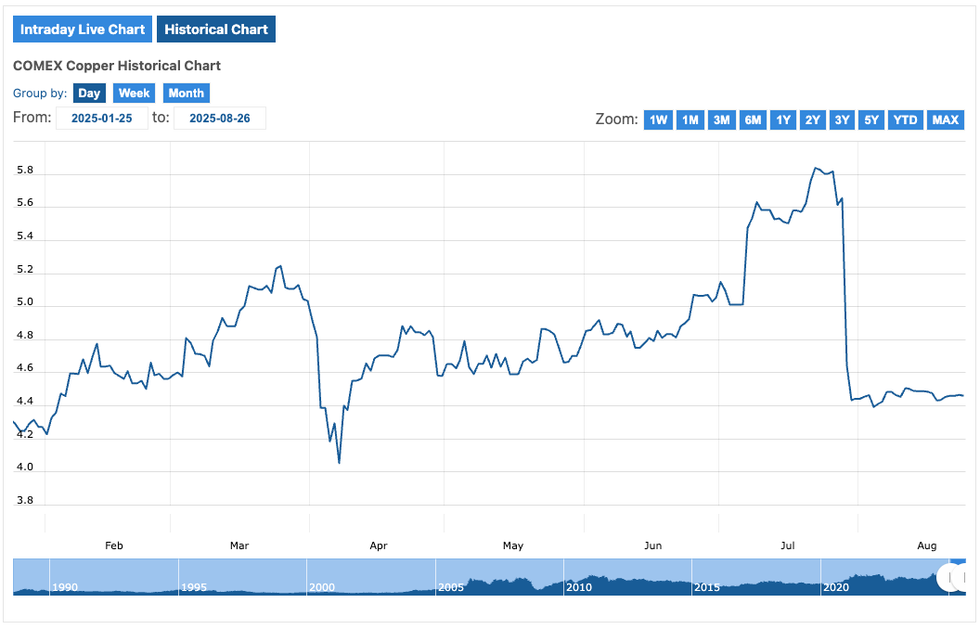
Copper price, January 1, 2025, to August 25, 2025.
Chart via Comex Live.
Ultimately, the Trump administration said on July 30 that copper tariffs would only be applied to unrefined copper, semi-finished and copper-intensive derivatives like pipe fittings, cables, connectors and electrical components.
Refined copper will be phased in at 15 percent in 2027 and 30 percent in 2028.
The move essentially pulled the rug out from prices and caused Comex copper to plummet nearly 25 percent.
Will copper tariffs boost US production?
Copper is increasingly being viewed as a critical mineral, and there are clear reasons why the US would want to increase production of the metal. But what do Trump's tariffs really mean for supply?
Taking a look at how US steel and aluminum tariffs played out in 2018, during Trump's first presidency, could provide insight. A March article published by Reuters analyzes the overall impact of those tariffs.
Prices started to rise in the lead up to the expected tariff deadline, similar to what happened with copper this time around, as importers began stockpiling products ahead of fee implementation. Steel prices rose 5 percent within a month of the tariffs being applied, while aluminum prices rose 10 percent. While they began to fall after just a few months, there was still a significant gap between prices for these products in the US and the rest of the world.
There were also more pronounced fluctuations between US and world prices as COVID-19 pandemic supply chain disruptions further impacted the steel and aluminum sectors.
While the steel and aluminum tariffs did stimulate domestic production of these materials, they ultimately weren't enough to overcome the price differential, as increased US output also faced headwinds.
The US is facing these same challenges with copper production. According to the US Geological Survey, in 2024 the US produced 1.1 million metric tons of unrefined copper and 850,000 metric tons of refined products. The US also exported 320,000 metric tons of concentrates and 60,000 metric tons of refined copper.
However, US demand requires 1.8 million metric tons of refined product annually, more than double US capacity — that's a key reason why refined products were exempted from tariffs.
In an email to the Investing News Network, Lauren Saidel-Baker, CFA, and economist with ITR Economics, spoke about the challenges that copper tariffs could pose to the US economy:
“The US does not have the capacity to produce all the copper that we consume. While there have been investments in new mining capacity, these facilities will take years to come online, leaving US businesses reliant on copper imports for at least the near term."
Although copper is classified as a critical mineral in the US, expanding existing operations will take years, and the time from discovery to opening a new mine could still take more than a decade.
One project nearing completion is Taseko Mines' (TSX:TKO,NYSEAMERICAN:TGB) Florence property in Arizona. The company acquired the asset in 2014, but a March 2023 technical report shows exploration dates back to the 1970s. After environmental assessments, permitting and the building of a test facility between 2017 and 2020, Taseko started full-scale construction of the mine in 2024, with the expectation that operations will begin in late 2025.
Likewise, new smelting operations will not come online until after the first phase of tariffs on refined copper are added in 2027. The newest smelter in the US is Aurubis' (OTC Pink:AIAGF) Richmond facility in Augustus, Georgia. The facility was designed to domesticate some of the more than 900,000 metric tons of scrap copper exported from the US to smelting facilities overseas each year. Construction took four years and US$800 million.
Once operational, the plant will produce 70,000 metric tons of refined copper annually, which is less than 10 percent of annual copper imports to the US.
Copper tariffs could weigh on other industries
Time isn't the only factor hindering the expansion of US copper production.
Mining is an energy-intensive business, and as demand for electricity grows, copper smelters may have to compete with other entities, similar to what happened in the steel and aluminum sector in 2019.
An April McKinsey report suggests that US power demand will grow at a CAGR of 3.5 percent, increasing from around 4,000 terawatt hours (TWh) in 2025 to about 5,000 TWh in 2030 and 7,000 TWh by 2040.
The report states that this increased demand could lead to bottlenecks as providers are faced with supply chain issues and shortages of dispatchable power as new projects face delays due to labor shortages and multi-year lead times for necessary equipment. It also notes that retail electricity bills have increased 6 percent per year since 2020.
The alternative for the copper sector would be to incur further capital costs by investing in off-grid capacity — this might also be affected by tariffs, as has been seen with photovoltaic imports.
The Reuters report evaluating steel and aluminum tariffs notes that the fees were ultimately lifted in 2019 due to the high cost of electricity and limited demand. The downstream effects meant that the manufacturing, construction and transportation industries faced higher costs, reducing growth in those sectors.
Likewise, a small uptick of about 8,000 jobs in the steel and aluminum sectors was outweighed by losses in other industries as companies sought to offset higher costs through efficiency gains.
One study concluded that the tariffs resulted in the loss of 75,000 manufacturing jobs.
Although the bulk of copper tariffs will be phased in starting in 2027 and 2028, that may not provide enough lead time to build new operations and ensure they have the inputs they need to carry out business.
If applied incorrectly, tariffs could have significant consequences for industries that rely on the red metal, including tech and construction, while also impacting overall economic growth.
“Tariffs will increase the cost to US importers and consumers of copper and related products, and will put downside pressure on potential growth,” Saidel-Baker said.
What should investors know about copper tariffs?
For investors interested in copper, the long-term picture is key.
Although Trump's scaled-back tariff announcement caused a price pullback, demand for copper is expected to significantly outweigh supply in the coming years, with experts calling for consumption from the tech industry and energy transition to add to growing requirements from urbanization in the Global South.
Whether tariffs will provide a competitive advantage for copper companies already producing and serving the US market remains to be seen, but some market watchers see potential for that to happen.
For example, Morgan Stanley (NYSE:MS) upgraded its price target for Freeport-McMoRan (NYSE:FCX) to US$48 on August 11. In its reasoning, Morgan Stanley said that the market is not currently appreciating the benefits Freeport will gain from the tariffs, also noting that it will be able to raise pricing for 2026 copper rod contracts, a semi-finished product, which accounts for the majority of the company’s North American sales volume.
Robert Friedland, founder and co-chair of Ivanhoe Mines (TSX:IVN,OTCQX:IVPAF), has come out in support of the tariffs, suggesting that they will help to rebuild the US copper industry. His reasoning is based on the national security issues inherent to having a single country dominate nearly 50 percent of the market of such a critical mineral.
Tariffs apply a new layer of uncertainty to an already challenging copper supply scenario. If tariffs are phased in gradually and industry is given the proper amount of time and investment, it could lead to a resurgence in US copper production and be a boon for those projects already in development; if not, then it could be a replay of 2018.
Don't forget to follow us @INN_Resource for real-time updates!
Securities Disclosure: I, Dean Belder, hold no direct investment interest in any company mentioned in this article.
Editorial Disclosure: The Investing News Network does not guarantee the accuracy or thoroughness of the information reported in the interviews it conducts. The opinions expressed in these interviews do not reflect the opinions of the Investing News Network and do not constitute investment advice. All readers are encouraged to perform their own due diligence.
Keep reading...Show less
22 August
Private Placement to Raise $510.8K
21 August
Top 5 Copper Reserves by Country
Copper has become a hot topic due to its role in the green energy transition and its necessity for urbanization. However, the lack of incoming supply in the long term has experts concerned.
Due to its importance in construction, energy transmission and new technologies, copper is a critical metal needed to power the future of our society. However, mined supply has not kept pace with demand, with few new operations coming online, and older mines facing decreasing grades and lower outputs.
The term “peak copper” was coined because some experts believe that copper reserves may be diminishing. According to the US Geological Survey (USGS), more than 700 million metric tons of copper have been mined throughout history, and current economic global copper reserves stand at 980 million metric tons.
Nearly all of that mined copper is still in circulation, as the red metal’s recycling rate is higher than that of any other engineering metal, but it is still not enough to keep up with escalating demand. As a result, it’s prudent to know the top copper reserves by country, especially when considering investing in the copper mining industry.
Reserve data for this article was sourced from the USGS's 2025 Mineral Commodity Summary and supplemented with datasets from Mining Data Online (MDO) and the UN Comtrade Database.
Top 5 copper reserves by country
The countries with the largest copper reserves are Chile, Australia, Peru, the Democratic Republic of Congo (DRC) and Russia. These five countries hold more than 55 percent of the world’s total copper reserves and will be critical to a world with soaring demand for copper.
Read on to learn about these copper kingpins.
1. Chile
Copper reserves: 190 million metric tons
Chile holds the largest copper reserves globally at 190 million metric tons, nearly as much as Australia and Peru hold combined. Additionally, Chile is also the world's top copper producer, with its 5.3 million metric tons of copper in 2024 representing nearly a quarter of global output.
The mining industry is essential to the Chilean economy, making up more than 50 percent of the country's exports and contributing US$40 billion of its GDP in 2023. Copper alone accounting for more than US$29 billion of that total.
Due to the sheer quantity of copper in the country, it should come as no surprise that Chile is home to the world’s largest copper mine, Escondida. According to MDO, Escondida produced 927,000 metric tons of copper in concentrate in 2024 and sits atop proven and probable copper reserves of 37.62 million metric tons. The mine is a 57.5/30/12.5 joint venture between BHP (ASX:BHP,NYSE:BHP,LSE:BHP), Rio Tinto (ASX:RIO,NYSE:RIO,LSE:RIO) and Japan’s JECO.
2. Australia
Copper reserves: 100 million metric tons
Australian copper reserves are pegged at 100 million metric tons, tying it for the second largest country by copper reserves. The resource industry is an essential sector in Australia, contributing AU$385 billion during the 2024/2025 fiscal year. Of that, copper was the sixth largest contributor with AU$13.2 billion, a AU$1.8 billion increase over 2023/2024.
While Australia hosts significant copper reserves, it lags the other countries on the list with similarly sized reserves in terms of production at 800,000 metric tons in 2024. More than a quarter of that came from BHP’s Olympic Dam mine in South Australia, which produced 216,000 metric tons of copper cathode. The polymetallic mine contains substantial proven and probable copper reserves totaling 10.68 million metric tons.
Another significant operation in Australia is Newmont's (TSX:NGT,NYSE:NEM,ASX:NEM) Cadia Valley mine, which hosts probable reserves of 3.1 million metric tons of contained copper. Cadia Valley produced 87,000 metric tons of copper in concentrate in 2024.
2. Peru
Copper reserves: 100 million metric tons
Copper reserves in Peru stand at 100 million metric tons, tying it with Australia for the second largest copper country. Much like its neighbor Chile, copper is an essential part of Peru’s economy, accounting for 49 percent of the value of its US$47.7 billion in mining exports.
Peru is home to some of the world’s biggest mining operations, and produced 2.6 million metric tons of copper last year. Two mines accounted for a third of the country’s total output.
The top producer in the country is the Cerro Verde Complex, a 55/21/19.6 venture with Freeport-McMoRan (NYSE:FCX), Sumitomo Metal Mining (TSE:5713) and Minas Buenaventura (NYSE:BVN). Cerro Verde hosts hosts proven and probable reserves of 11.45 million metric tons of copper and produced 949 million pounds of copper metal in concentrate in 2024.
Not to be outdone, the second highest is Antamina, a 33.75/33.75/22.5/10 joint venture between BHP, Glencore (LSE:GLEN,OTC Pink:GLCNF), Teck Resources (TSX:TECK.B,TSX:TECK.A,NYSE:TECK) and Mitsubishi (TSE:8058). Last year, output at the mine fell just short of Cerro Verde's at 941 million pounds of copper in concentrate. Antamina hosts a proven and probable reserve of 4.53 million metric tons of contained copper.
The mine with the largest copper reserves in Peru is Southern Copper's (NYSE:SCCO) Toquepala mine, home to 13.79 million metric tons of copper in proven and probable reserves. The mine produced 496 million pounds of copper in concentrate last year.
4. Democratic Republic of Congo
Copper reserves: 80 million metric tons
Copper reserves in the Democratic Republic of Congo stood at 80 million metric tons in 2024, making it the fourth largest country by copper reserves. The DRC's economic copper reserves have seen a staggering rise in recent years, climbing from an estimated 19 million metric tons in 2019.
The mining sector has been critical to GDP growth in the DRC, with copper being the largest contributor. World Bank reports that the extraction sector has outpaced other segments of the DRC's economy, increasing 12.8 percent in 2024, while non-mining sectors grew by only 3.2 percent.
According to data from the United Nations, in 2023 the DRC exported US$17 billion in refined copper and unwrought alloys, a large jump from US$7.34 billion in 2019. The country's copper ore exports contributed US$2.16 billion in 2023, nearly double the US$1.11 billion four years prior.
Among the contributing factors in the rise in mining and export activity has been the development of the Lobito Corridor, which connects mineral-rich regions in Zambia, the DRC and Angola to the port at Lobito in Angola.
This link allows greater access for large-scale operations like Ivanhoe Mines (TSX:IVN) and Zijin Mining's (HKEX:2899,SHA:601899) Kamoa-Kakula complex in the Southern DRC. One of the largest copper operations in the world, Kamoa-Kakula hosts a probable reserve of 17.69 million metric tons of contained copper and produced 964 million pounds of copper in concentrate in 2024.
4. Russia
Copper reserves: 80 million metric tons
Russia's copper reserves are estimated to be 80 million metric tons, tying it with the DRC. While commodities are important to the Russian economy, contributing US$417 billion in 2024, the metals sector represented 15 percent of that total at US$60 billion.
Russia has been under significant sanctions since it invaded Ukraine in February 2022. According to the UN Comtrade Database, Russia's copper exports from in 2021 were valued at US$5.98 billion.
In 2024, Russia produced 930,000 metric tons of copper, an increase from the 890,000 metric tons produced in 2023. Among the main contributing factors was a ramp-up in production at Udokan Copper’s Udokan mine in Siberia, which was expected to produce 135,000 metric tons in 2024 and, according to the mine's website, hosts a JORC-compliant copper resource of 26.7 million metric tons.
Don’t forget to follow us @INN_Resource for real-time news updates!
Securities Disclosure: I, Dean Belder, hold no direct investment interest in any company mentioned in this article.
Keep reading...Show less
Latest News

Sign up to get your FREE
Aston Bay Holdings Investor Kit
and hear about exciting investment opportunities.
- Corporate info
- Insights
- Growth strategies
- Upcoming projects
GET YOUR FREE INVESTOR KIT
Latest Press Releases
Related News
TOP STOCKS
American Battery4.030.24
Aion Therapeutic0.10-0.01
Cybin Corp2.140.00










